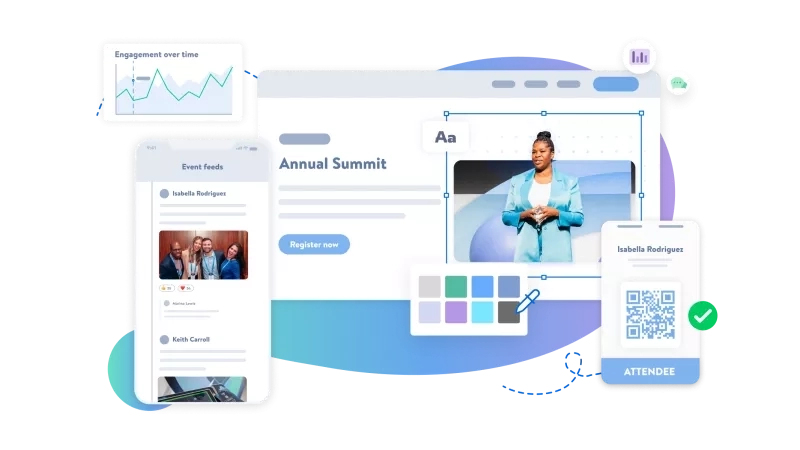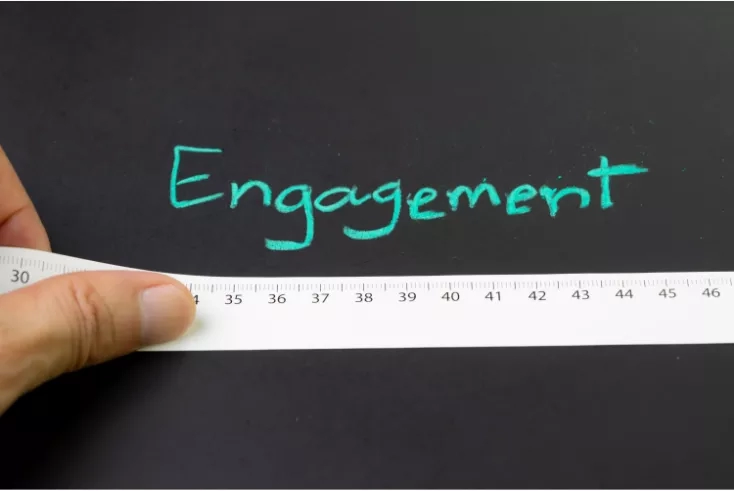Webinars have become a key component in marketers' strategies, offering so many of the benefits of virtual events. While attendees reap the benefits of the professional, knowledge-driven format of webinars, those who host them can enjoy immense advantages to their marketing and sales funnels.
These days, webinars are used by organizations for lead generation, product demonstrations, increased reach and brand awareness, and knowledge sharing. If you can get your online webinar management strategy right, B2B marketers say webinars are their second-most effective distribution channel (51%) right after in-person events (52%).
Of course, with increased expectations for live online events comes the need for higher standards when hosting webinars. Attendees see the technological innovations happening, and it's up to event organizers and marketers to stage engaging webinars that go beyond basic broadcasts. To do this, it requires the right webinar platform and a solid webinar strategy.
A guide to online webinar management in 2025
We can't get complacent with our webinars and think what's worked in the past is going to mean success today. While you might associate webinars with a standard pre-recorded video complete with talking head over a slide deck, that model is long gone (and if you're still operating this way, believe us: your attendees expect far more).
This status quo experience isn’t limited to your attendees, either. On the presentation side, you likely have suffered through static experiences, fixated on clicking through slides and talking heads with limited capabilities beyond running simple presentations or polling. Even reporting was limited to how many people attended and how long they stayed.
Three pitfalls of status quo webinars:
- They offer little if any interaction between the speaker and attendees or between attendees. Limited engagement and opportunities for attendee interactivity lead to lower overall engagement.
- Follow-up takes place on the event organizer’s schedule, not the attendees’. Attendees prefer webinar experiences with a Q&A session and follow-up opportunities that are in real-time or scheduled for other times that meet their own needs.
- They provide minimal flexibility in the attendee experience. Inflexibility in webinar scheduling, offering only live content or content on-demand, and limited program interactivity may lead to a negative webinar experience for the attendees.
Three goals for successful webinars:
- Generate measurable results: Before you can think about topics, you need to understand your goals and KPIs. The most effective webinars have specific and measurable goals.
- Deliver value to your attendees: The best webinars aim to provide real value to their audience first and foremost. Cover topics your audience cares about and deliver it in a compelling format with visual and interactive elements.
- Drive action: Too often webinars are a dead-end, with an obligatory CTA on the final slide. After you’ve established a clear goal and know how your webinar fits into the buyer’s journey, you can drive webinar registrants to the next important action.
How to enhance your webinars and choose the right platform
For webinars to be reimagined, we need to enhance four key elements—content, formats, production, and interactivity driven by technology.
Webinar content
Digital event attendees recognize that quality content is the driving force behind their commitment to logging on and remaining engaged. To ensure webinar content has the same appeal, consider a series approach by focusing on one core webinar theme and then offer multiple webinars on related sub-topics.
By doing so, you will extend the attention and time spent with your brand through more binge-worthy moments.
Focus on more personalized content to promote your webinars too. By using an online attendee registration and management system, you can send personalized promotions to specific audience segments with customized messages and dynamic registrations that will deliver content recommendations that resonate only with them.
Then, when they join the webinar, attendees will know which topics will be relevant to them before the programming even begins.
During the event, engage attendees in the webinar chat and Q&A. By knowing your audience and personalizing their experience, you can direct them to resources and additional content of interest after the webinar ends.
Webinar formats
Be creative and flexible with webinar timing and duration—it’s ok to break away from the traditional 30-45 minute time template!
Webinars should be thought of as multi-layer experiences. In addition to showcasing programmed content, consider adding breakout sessions or pre-and/or post-webinar Q&A opportunities.
Offer to continue the webinar conversation by allowing attendees to virtually “meet” the experts by participating in smaller breakout-discussion groups moderated by the speakers.
It’s also important to focus on the speaker's experience. By utilizing a roundtable-style format, you’ll be able to allow multiple speakers to engage in a live conversation together while attendees watch.
Think of it as a talk show—speakers get to have a dynamic conversation with each other that is unscripted and authentic and piques the attendees’ interest.
Mixing up webinar formats supports attendee engagement by allowing networking opportunities, attendee-to-attendee interaction, and attendee-to-speaker interaction.
Webinar production tools and features
To cater to the eight-second human attention span, reimagine your role as that of executive producer, versus simply delivering a presentation.
By upping your webinar production game and keeping a quick pace, you will bring the content to life, hold attendees’ interest, and elevate the overall experience of the webinar.
During the session, change up the screen layouts and views with a variety of screen dynamics.
Some options include rotating from the speaker in a full-screen view to the content as a full-screen view with a voiceover or using a side-by-side view of the speaker and content.
Use the entire presentation screen to your advantage. By adding fun facts, important statistics, and other details to the lower third of your presentation screen, you can elevate the visual experience of the webinar and keep attendees' eyes scanning across the screen, instead of straight-ahead in webinar-zombie mode.
A lower third is a graphic that appears on the lower third of a video screen and draws a viewer’s attention to the content included there. The information often includes details about the speaker or additional context pertaining to what is being viewed—just like the breaking-news ticker on your favorite news broadcast.
When hosting the webinar, be sure to utilize proper speaker lighting, high-quality microphones, and unique backgrounds to limit distractions in non-professional studio spaces while maintaining the webinar’s visual and audio appeal.
Need a webinar platform that can help you achieve all this? You're not alone. 34% of marketers say their organizations will increase their investment in webinars in 2025, which means you're in good company if you're looking to invest more in this lucrative marketing tactic.
Interactivity
Encouraging attendee interactivity will improve their overall webinar experience and will get them and keep them engaged.
Use a webinar platform that allows attendees to type in live Q&A and to up-vote questions to prioritize speaker responses.
Offering live polls throughout the webinar will also engage attendees, with the added bonus of collecting additional viewer data.
The use of breakout sessions/ rooms during a webinar will also heighten attendee engagement. By quickly splitting attendees into small breakout groups during the webinar, they’ll be able to engage around a specific topic in a more intimate setting before being brought back into the main webinar session.
Enhancing attendee interactivity will create a more comprehensive webinar experience and make attendees feel like they are part of the session and a bigger community, as opposed to being simply external observers.
Metrics and measurement
Standard webinars measure success via registration, overall attendance, and duration of attendance. Whilst these are still important metrics to collect, aspire to go a layer deeper in order to justify ROI.
By tracking engagement and how viewers participated during the live-interaction segments of your webinar (e.g. in polls, Q&A, and chat), you can determine how engaged any specific attendee was and view and follow up with their individual responses during these segments.
Using this data, you then can capture attendees and calculate your next best offer: either delivering them to sales as new leads or continuing to nurture them in existing marketing programs evolving their interests, based on the content they have consumed or their captured responses.
Post-webinar attendee surveys
After the initial speaker registration, use those responses to personalize your outreach to attendees further. This may include requesting additional information on topics of interest, what their learning objectives are for the session, plus if they have any questions to submit in advance.
After the webinar, be sure to send out a post-webinar survey, which is as customized and personalized as possible.
The feedback you receive from the post-webinar survey will provide an additional level of insight direct from the attendees (as opposed to inferred engagement), which can be equally as valuable to improve the quality of the content you presented, determine follow-up needs, and identify warm-to-hot leads.
By looking beyond attendance metrics and implementing survey feedback, over time you can build a full funnel to prove your business impact. Using the best practices we discussed above, your process will look like this:
- Capture the attention of your attendee, and for a longer time
- Draw deeper insights based on this engagement
- Build a clearer picture of interest
- Accelerate intelligent follow-up
- Prove the business impact
Get started with a comprehensive webinar checklist
Ready to start building your webinar strategy? Check out our complete webinar checklist!
Eight weeks prior
- Pick your date and time
- Determine your topic
- Select your speakers/host(s)
- Set your objectives
- Reach out to sponsors and stakeholders
Remember: When choosing a time and date for your webinar, first consider your process. How long will it take to find a speaker, build the event, create a marketing campaign, and so on? With an idea of how long it will take to execute, it’s time to open the calendar. Go as many weeks in advance as it will take to build the webinar. Webinars that take place on Tuesday, Wednesday, or Thursday see higher registration than those on Monday or Friday.
Five weeks prior
- Create a webinar registration page
- Select webinar software platform
- Create a content outline and program schedule
Remember: Many companies have their own terminology and are used to phrasing things in a specific way. But that doesn’t mean attendees speak the same language. As you refine your webinar topic, look to SEO keywords to guide the way. You’ll want to create an engaging title that will show up in search, one that explains what the webinar is about.
Three weeks prior
- Begin webinar promotion via email, social, partners, paid promotion, and customer communication
- Complete webinar promotion designs
Remember: An email marketing campaign isn’t one email – it’s a series. Build emails that aren’t too text-heavy and utilize great visuals. When writing a subject line, keep it short and engaging. The goal of these emails is to drive the recipient to the webinar website. Be creative and have fun with these. Think about what would make you open an email as you write them.
One week prior
- Send a reminder email to registrants
- Re-promote webinar
- Rehearse content
Remember: Give yourself enough time to do at least two complete dummy run-throughs of the webinar so that the moderator can test scripts, platform engagement tools can be planned and added to the schedule and last-minute moments of pre-show stress can be avoided. If speakers are remote, make sure they have the correct lighting, bandwidth, and set-up in place and that they’re comfortable with their role in the program.
Day of webinar
- Send a reminder email to registrants
- Promote via social media
- Gather speakers 30 minutes before the webinar is due to start
Remember: Make sure sales and marketing are aligned throughout the webinar cycle. Sales can support marketing by closing the feedback loop on what webinar topics resonate with prospects and customers and which topics are ripe for a webinar not yet created. Marketing can use this data from sales to develop webinars that are even more effective in attracting the right kind of prospect.
During webinar
- Record sessions
- Encourage social media activity
- Facilitate Q&A, polls, and real-time surveys
Remember: What’s the next step you want webinar registrants to take and how will your sales team help you coordinate the Call-to-Action?
After the webinar
- Update landing page copy
- Convert recording to MP4 file and upload to your website
- Upload shareable content assets to the website
- Send thank-you email with links to assets and recording
- Pass-on sales leads and interest levels to the commercial team
- Analyze metrics and performance
Remember: Analyze and distribute webinar data to sales teams, detailing leads who registered, leads who attended, leads who registered but didn’t attend, leads who never registered, and additional information such as webinar poll responses, survey answers, and questions asked during the webinar.
With the right approach, you can elevate your webinar productions to new highs by driving more engagement, leads, and revenue than ever before. Access this eBook for more advice, tactics, and tools to reimagine your webinars, whether you’re a veteran or just getting started.
See how the Cvent Webinar Platform can help you create your next successful webinar.












